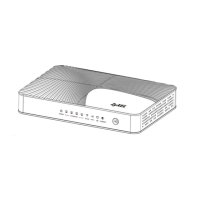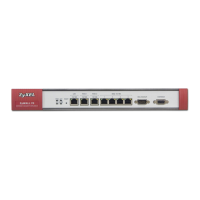Chapter 6 Broadband
AMG1302-T11C User’s Guide
75
Figure 21 Network Setting > Broadband > Internet Connection: Advanced Setup
The following table describes the labels in this screen.
Table 12 Network Setting > Broadband > Internet Connection: Advanced Setup
LABEL DESCRIPTION
RIP Direction RIP (Routing Information Protocol) allows a router to exchange routing information
with other routers. Use this field to control how much routing information the
AMG1302-T11C sends and receives on the subnet.
Select the RIP direction from None, Both, In Only and Out Only. This field is
configurable only when you select Ethernet(ETH1) in the Type field.
RIP Version This field is not configurable if you select None in the RIP Direction field.
Select the RIP version from RIP-1, RIP2-B and RIP2-M.
Multicast Multicast packets are sent to a group of computers on the LAN and are an alternative
to unicast packets (packets sent to one computer) and broadcast packets (packets
sent to every computer).
Internet Group Multicast Protocol (IGMP) is a network-layer protocol used to establish
membership in a multicast group. The AMG1302-T11C supports IGMP-v1, IGMP-v2
and IGMP-v3. Select None to disable it.
MLD Proxy Select the version of MLD proxy (v1 or v2) to have the AMG1302-T11C act as for this
connection. This allows the AMG1302-T11C to get subscription information and
maintain a joined member list for each multicast group. It can reduce multicast traffic
significantly. Select None to turn off MLD proxy.
ATM QoS
ATM QoS Type Select CBR (Continuous Bit Rate) to specify fixed (always-on) bandwidth for voice or
data traffic. Select UBR With PCR (Unspecified Bit Rate) for applications that are
non-time sensitive, such as e-mail. Select Realtime VBR (real-time Variable Bit
Rate) type for applications with bursty connections that require closely controlled
delay and delay variation. Select Non-Realtime VBR (non real-time Variable Bit
Rate) type for connections that do not require closely controlled delay and delay
variation.
Peak Cell Rate Divide the DSL line rate (bps) by 424 (the size of an ATM cell) to find the Peak Cell
Rate (PCR). This is the maximum rate at which the sender can send cells. Type the
PCR here.
Sustain Cell Rate The Sustain Cell Rate (SCR) sets the average cell rate (long-term) that can be
transmitted. Type the SCR, which must be less than the PCR. Note that system default
is 0 cells/sec.

